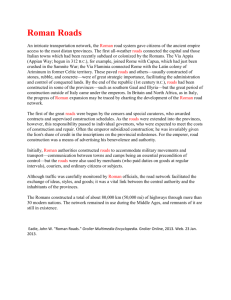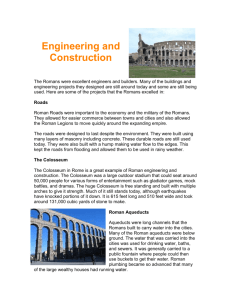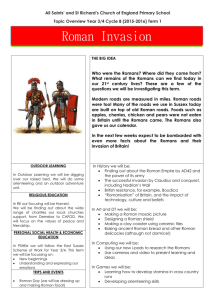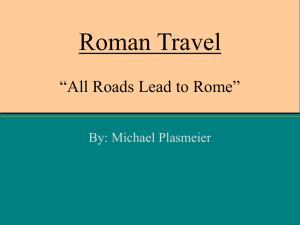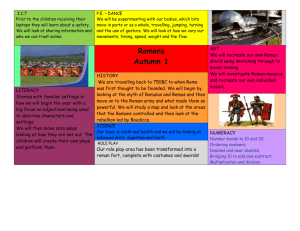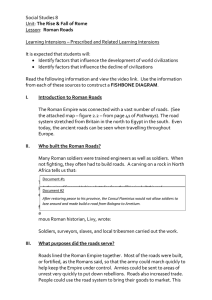Roman Architecture - Bishop Ireton High School
advertisement
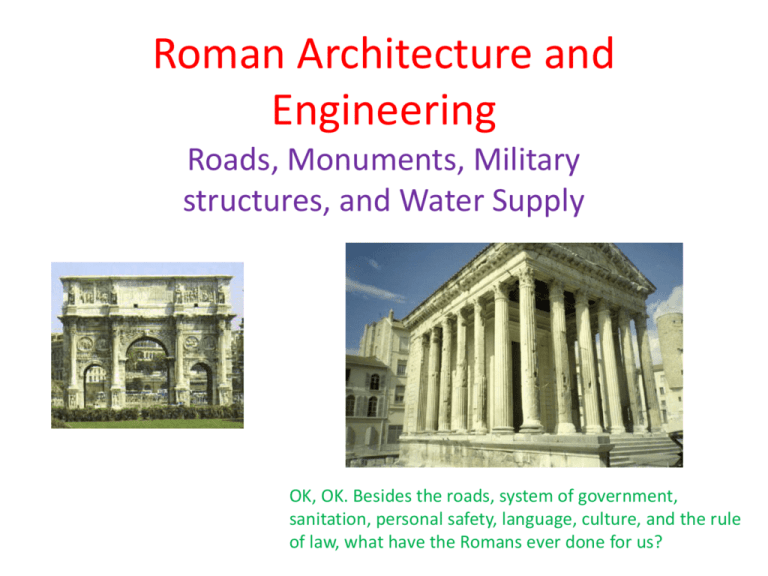
Roman Architecture and Engineering Roads, Monuments, Military structures, and Water Supply OK, OK. Besides the roads, system of government, sanitation, personal safety, language, culture, and the rule of law, what have the Romans ever done for us? Roman Roads There is an old saying that ‘all roads lead to Rome,’ which is based on the fact that, wherever the Romans spread their influence, they built roads, called viae. The first of these was the Via Appia. These roads were first and foremost for military purposes. Especially beginning with Gaius Marius, the army would actually build its roads as it advanced. After they were built, they were also very useful for trade, travel, and the movement of mail and news. Roman roads depended for their construction on the materials available. Ideally, they consisted of large flagstones over various layers of tamped rubble and gravel (strata) either laid into a ditch or in a berm over the surrounding terrain. Roads were designed by expert surveyors and engineers and tended to follow as straight a path as possible -- aiming for rapid travel over ease of construction or attractive scenery. Some old Roman roads and bridges were wellbuilt enough that they are still in use today. Military Structures Roads may have been the most important, but the Romans built many other military structures as well. The Roman army built fortified camps daily, and won many difficult battles through battlefield engineering. Some frontiers of particular importance were fortified with huge walls which kept enemies from crossing unobserved; the most famous of these in Hadrian’s Wall in Britain. It was about ten feet wide and 16-20 feet tall, with gates every mile flanked by watchtowers and several forts built in to house Roman legions. Its ruins still exist, and are ten feet high in some sections. The Water Supply Perhaps more than any other civilization before them (and for a long time after), the Romans understood the importance of a fresh, clean water supply. Some of Rome’s greatest architecture revolved around supplying water, making it useful, and then taking it away in a hygienic fashion. Aqueducts were tunnels which carried water from fresh springs to Roman cities. They were usually underground, but the famous bridges were used to carry them across valleys. Sewers (cloacae) then carried filthy water out of the cities. Once it was in the city, water for personal use went either into public fountains or was piped to the houses of the very wealthy. Much of the remainder went into Rome’s splendid bath complexes, or thermae. Most cultures at this time bathed only very rarely. Romans hoped to bathe often, ideally daily. Public bathhouses were built where Romans, often for a small fee, could clean themselves and relax. They served as everything from swimming pools to gymnasia to social clubs -- friends and business partners would gather to talk, exercise, relax, or snack while they soaked. Baths had many rooms, including the apodyterium for changing, the frigidarium for cold dips, the tepidarium for warm baths, and the caldarium for hot steaming. Heat was provided by an underground furnace called a hypocaust which circulated hot air under the floor. Bathers cleaned with perfumed olive oil and a strigil. Ancient Roman bathhouses survived in the old provinces, and were adopted by, for example, the Turks. The baths of Aquae Sulis in England gave the modern town of Bath its name. Monumental Buildings Rome contained a number of huge public buildings for various purposes. Some, like the tombs along the Via Appia or Hadrian’s Mausoleum (now the Castel Sant’Angelo), remembered the dead. Others, like Jupiter Optimus Maximus or the Pantheon, were temples to honour the gods. Perhaps the best known, however, are the buildings for public entertainment. The Flavian Amphitheatre housed gladiatorial combats, executions, and venationes for some 50,000 or so spectators, free of charge. Even larger was the Circus Maximus, built into a natural valley and added on to in several stages, which was the setting for races and parades for 100,000 viewers.

